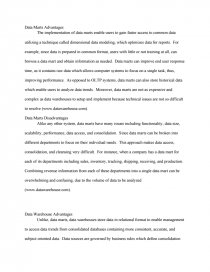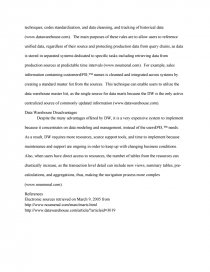Data Marts Advantages & Disadvantages
Essay by review • February 23, 2011 • Essay • 494 Words (2 Pages) • 4,536 Views
Data Marts Advantages
The implementation of data marts enable users to gain faster access to common data utilizing a technique called dimensional data modeling, which optimizes data for reports. For example, since data is prepared in common format, users with little or not training at all, can browse a data mart and obtain information as needed. Data marts can improve end user response time, as it contains raw data which allows computer systems to focus on a single task, thus, improving performance. As opposed to OLTP systems, data marts can also store historical data which enable users to analyze data trends. Moreover, data marts are not as expensive and complex as data warehouses to setup and implement because technical issues are not so difficult to resolve (www.datawarehouse.com).
Data Marts Disadvantages
Alike any other system, data marts have many issues including functionality, data size, scalability, performance, data access, and consolidation. Since data marts can be broken into different departments to focus on their individual needs. This approach makes data access, consolidation, and cleansing very difficult. For instance, when a company has a data mart for each of its departments including sales, inventory, tracking, shipping, receiving, and production. Combining revenue information from each of these departments into a single data mart can be overwhelming and confusing, due to the volume of data to be analyzed (www.datawarehouse.com).
Data Warehouse Advantages
Unlike, data marts, data warehouses store data in relational format to enable management to access data trends from consolidated databases containing more consistent, accurate, and subject-oriented data. Data sources are governed by business rules which define consolidation techniques, codes standardization, and data cleansing, and tracking of historical data (www.datawarehouse.com). The main purposes of these rules are to allow users to reference unified data, regardless of their source and protecting production data from query drains, as data is stored in separated systems dedicated to specific tasks including retrieving data from production sources at predictable time intervals (www.noumenal.com). For example, sales information containing customers’ names is cleansed and integrated across systems by creating
...
...

